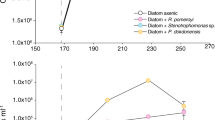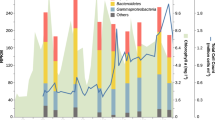Abstract
In aquatic ecology it is assumed that the heterotrophic (non-photosynthetic) protozoa that are abundant in marine and fresh water cannot compete with smaller-sized bacteria for labile dissolved substrates of low relative molecular mass (Mr), such as simple sugars and amino acids, at the low concentrations found in situ1,2 (typically 1–100 μg litre−1) because of surface to volume considerations. Consequently dissolved organic matter (DOM) is not considered to be a source of nutrition for heterotrophic protozoa, which are thought to be predominantly phagotrophic on bacteria and other small planktonic cells2. But there is no information as to whether protozoa might be able to use DOM of higher Mr. Here I report that heterotrophic flagellates in a salt marsh estuary and in a freshwater pond were able to ingest molecules of the polysaccharide dextran of Mr> 500,000 (500K). Mixed species cultures of estuarine and pond flagellates also showed enhanced growth in the presence of 2,000K, but not 40K, dextran. Compounds with high-Mr are often a large fraction of total DOM in natural waters3,4, and the concentrations (dry weight litre−1) of some types of labile high-Mr compounds in natural waters are equal to, or greater than, those of bacterioplankton5,6. Thus DOM of high Mr may be an alternative food resource for aquatic flagellates. Direct ingestion of high Mr compounds by heterotrophic flagellates would represent a more efficient pathway for returning a portion of DOM to aquatic food webs compared with the DOM-bacteria-flagellate-ciliate microbial loop7.
This is a preview of subscription content, access via your institution
Access options
Subscribe to this journal
Receive 51 print issues and online access
$199.00 per year
only $3.90 per issue
Buy this article
- Purchase on Springer Link
- Instant access to full article PDF
Prices may be subject to local taxes which are calculated during checkout
Similar content being viewed by others
References
Haas, L. W. & Webb, K. L. J. exp. mar. Biol. Ecol. 39, 125–134 (1979).
Fenchel, T. The Ecology of Protozoa (Science Tech. Madison, Wisconsin, 1987).
Wheeler, J. R. Limnol Oceanogr. 21, 846–852 (1976).
Ogura, N. Mar. Chem. 5, 535–549 (1977).
Burney, C. M., Johnson, K. M. & Sieburth, J. McN. Mar. Biol. 63, 175–187 (1981).
DeFlaun, M. F., Paul, J. H. & Jeffrey, W. H. Mar. Ecol. Prog. Ser. 38, 65–73 (1987).
Azam, F. et al. Mar. Ecol. Prog. Ser. 10, 257–263 (1983).
Lee, J. J., Hutner, S. Y. & Bovee, E. C. (eds) An Illustrated Guide to the Protozoa (Allen, Lawrence, Kansas, 1985).
Sleigh, M. A. The Biology of Protozoa (Arnold, London, 1979).
Rassmussen, L. & Orias, E. Science 190, 464–465 (1975).
Glaser, D. Microb. Ecol. 15, 189–201 (1988).
Lee, S. & Fuhrman, J. D. Appl. envir. Microbiol. 53, 1298–1303 (1987).
Vold, R. D. & Vold, M. J. in Encyclopedia of Chemistry (eds Clark, G. L. & Hawley, G. G.) 263–265 (Reinhold, New York, 1966).
Sherr, E. B., Sherr, B. F., Fallon, R. D. & Newell, S. Y. Limnol. Oceanogr. 31, 177–183 (1986).
Smetacek, V. & Pollehne, F. Ophelia 26, 401–428 (1986).
Ducklow, H. W., Purdie, D. A., Williams, P. J. leB & Davis, J. M. Science 232, 865–867 (1986).
Roman, M. R. et al. Mar. Ecol. Prog. Ser. 42, 39–52 (1988).
Sanders, R. W. & Porter, K. G. EOS 68, 1705 (1987).
Porter, K. G. & Feig, Y. S. Limnol. Oceanogr. 25, 943–948 (1980).
Sherr, B. F., Sherr, E. B., Andrew, T. L., Fallon, R. D. & Newell, S. Y. Mar. Ecol. Prog. Ser. 32, 169–179 (1986).
Hobble, J. E., Daley, R. J. & Jasper, S. Appl. envir. Microbiol. 33, 943–948 (1977).
Author information
Authors and Affiliations
Rights and permissions
About this article
Cite this article
Sherr, E. Direct use of high molecular weight polysaccharide by heterotrophic flagellates. Nature 335, 348–351 (1988). https://doi.org/10.1038/335348a0
Received:
Accepted:
Issue Date:
DOI: https://doi.org/10.1038/335348a0
This article is cited by
-
Weak coupling between heterotrophic nanoflagellates and bacteria in the Yellow Sea Cold Water Mass area
Acta Oceanologica Sinica (2014)
-
Hidden diversity among aquatic heterotrophic flagellates: ecological potentials of zoosporic fungi
Hydrobiologia (2011)
-
The significance of transparent exopolymeric particles in the vertical distribution of bacteria and heterotrophic nanoflagellates in Lake Pavin
Aquatic Sciences (2010)
-
Microbial Exopolymers Link Predator and Prey in a Model Yeast Biofilm System
Microbial Ecology (2006)
-
Predation on prokaryotes in the water column and its ecological implications
Nature Reviews Microbiology (2005)
Comments
By submitting a comment you agree to abide by our Terms and Community Guidelines. If you find something abusive or that does not comply with our terms or guidelines please flag it as inappropriate.



